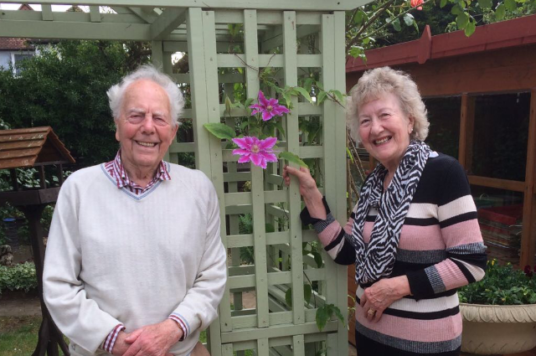Oldest implant patient hears family again
St George’s has fitted a new type of cochlear implant to the world’s oldest patient.
Raymond Kelly received his implant at nearly 91 after suffering with progressive hearing loss since childhood. He underwent the two hour operation at St George’s Hospital in March, which involves having the implant surgically placed under the skin of the head, and now tests have proved it was a success.
It means Mr Kelly, now 91 and from New Malden (pictured with wife Olivia), Surrey, is able to hear his 10 grandchildren and two great grandchildren for the first time.
A cochlear implant is a small electronic device that can help provide a sense of sound to someone who is deaf or severely hard of hearing. They cannot restore normal hearing but they can give a deaf person a good representation of sounds, meaning they can learn to understand speech again.
Raymond has suffered with hearing problems from a young age. At seven years old he was offered an operation but his parents refused as they were concerned about the risks involved.
Despite this he was active as a child and joined the Air Cadets during the Second World War. After two year’s training, Raymond wanted to join the Air Crew but his hearing let him down.
It wasn’t until Raymond was 34 that he had an operation on his right ear. Although it didn’t bring his hearing back, it did mean the ear was at lower risk of rupturing. In his late thirties he wore his first hearing aid.
Raymond said “I went on to have a successful 25 year career with British Aerospace where I drew intricate technical illustrations for Concorde, and other previous airliners, for publication. However, my hearing continued to deteriorate through the years. I was always very sociable but I started to stop going out as I could no longer hear what was going on.”
Raymond’s wife Olivia said: “Eventually last year we were referred to St George’s to see if Ray was suitable for a cochlear implant, which he was. We were all a bit nervous about the operation but he’s made a good recovery. I can’t believe the high standard of expertise at the hospital – everyone’s been amazing.”
Rob Harris, the Ear, Nose and Throat Consultant who carried out the implant, said: “Raymond is the oldest recipient of this particular electrode. It’s thinner than previous models, and not as disruptive.
“He’s a real character and very active for his age. The aim was to improve his hearing and allow him to maintain his independence. We’re lucky that St George’s is a centre of excellence for cochlear implants, and that we have a great team from across many clinical areas to carry out these complex procedures.”
The first sounds Raymond remembers hearing after the ‘switch on’ included birdsong, a ticking clock, and water splashing in a sink. “They were small things, but amazing to hear for the first time in decades,” he said.
Some aspects of his new hearing will take a bit more time to adjust to. For example listening to unfamiliar music can be patchy, and he has found that women’s voices are more difficult to make out compared to men’s.
However, Raymond said: “The implant has changed my life. It used to be so frustrating having to get people to write down what they wanted to say to me. Now I can hear my family’s voices, and listen to the radio and birds singing. I couldn’t be happier.”
Notes to editors
For more information, please contact Pippa Harper, Media Manager, on 020 8725 0724 or philippa.harper@stgeorges.nhs.uk



